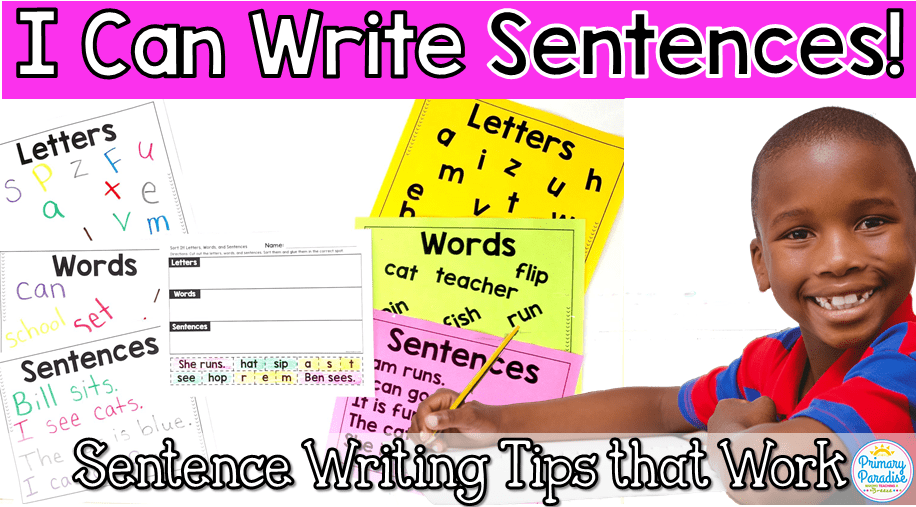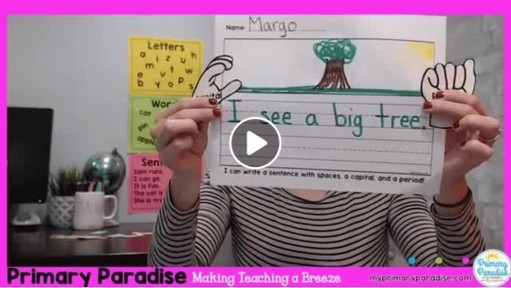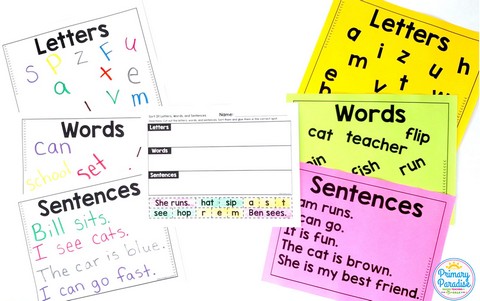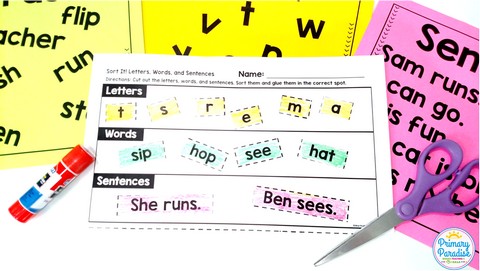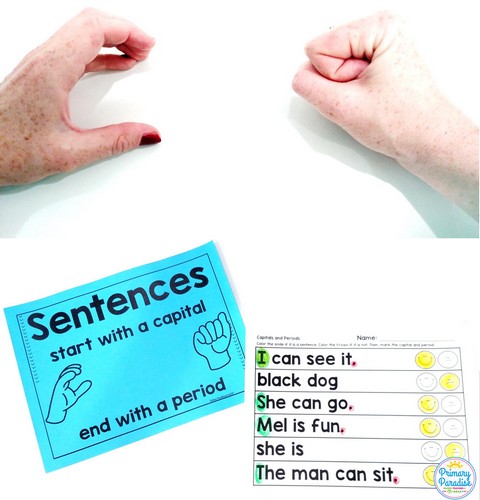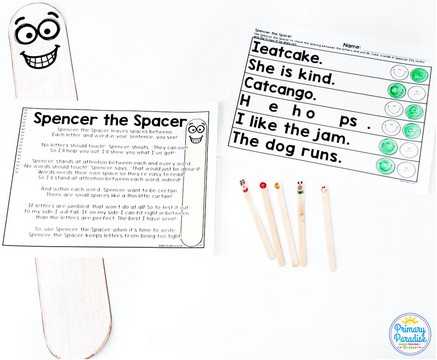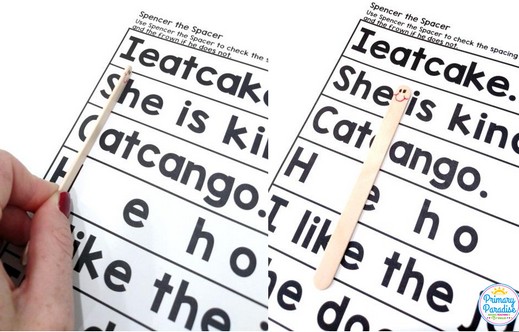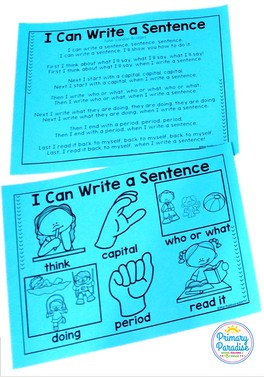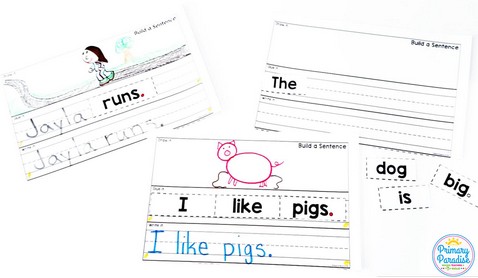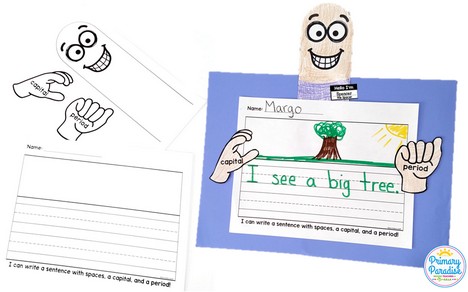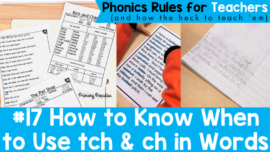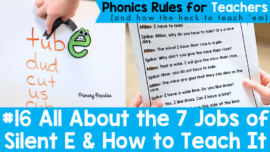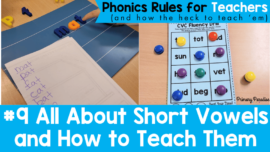Sentence writing: how do you teach young students such a complex skill? Today, I’m going to share some engaging ideas to teach students to write simple sentences with capitals, punctuation, and proper spacing. These ideas use a gradual release method, and typically take about a week. These lessons are helpful before beginning your writing curriculum for the year. It’s pretty difficult to write a story if you don’t know how to write a sentence. Looking for more advanced sentence writing ideas? Read this post.
Watch my live video about this topic on Facebook here.
Letters, Words, and Sentences, Oh My!
Before delving into sentences, it’s important to ensure that your students know the difference between what letters, words, and sentences look like. This lesson is simple but effective. It will also help you see where your students are. Create posters with your students (or make them ahead of time). Have students write all of the letters they know on one, examples of words on the next, and finally, together, write some sentences on the third. Discuss how we use letters to make words and words to make sentences.
Then, you can have your students sort letters, words, and sentences. This is a great activity to get students familiar with looking at and distinguishing what a sentence looks like.
Capitals and Periods
I know in all of my years of teaching, I felt as if I was constantly reminding students to begin their sentences with a capital and end them with a period. I was so excited when I decided to use this simple chant and hand motions to help solidify this idea in my students’ minds. You can look at the sentence poster you created in the previous lesson, and ask your students what they notice about the first word in every sentence and also what they notice at the end of each sentence. Every sentence starts with a capital and ends with a period! (Note: I realize there are other forms of punctuation, but remember, these lessons are for students who are brand new to sentence writing.)
Teach them to say “Sentences start with a capital” while making a c with their left hand. Repeat a few times. Then add “end with a period” and have students make a fist with their right hand. I would have my students chant this every time before beginning to write independently, and it really helped them remember both elements.
Next, you can have them practice finding the capital and period in sentences. I like to have them color the capital green (because it’s the start of the sentence) and the period red (because it’s the end of the sentence).
Spencer the Spacer
Oh, spacing. Spacing can be so difficult for many students, so I like to introduce them to Spencer the Spacer. He’s a giant popsicle stick who makes sure there are bigger spaces between words and little spaces between letters. Spencer should fit perfectly between each word. He should fit between words on his side. You can have students create their own Spencer the Spacer by giving them small popsicle sticks and either markers or small smile stickers.
Have students practice checking the space between letters and words so they can get comfortable with Spencer. Eventually, they won’t need to use him anymore, but he’s a great tool for beginner writers.
I Can Build Sentences
It might seem like I’ve waited a long time to actually have students write sentences, but using this gradual release method will allow students to feel confident that they know what they’re doing when it’s time to write. Lesson four is when students really get down to the work. Take time to review all of the things you’ve discussed so far. Then you can delve into the meat of sentence writing. Thinking before writing, starting with a capital, tell who or what (Timmy, dog, ball), what they’re doing (running, hopping, red), ending with a period, and then teaching students to go back and reread their sentence.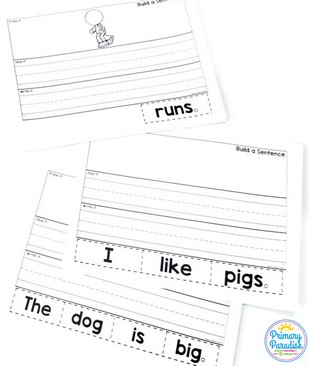
Next, you can have your students build sentences and copy them. Again, this allows them to feel confident in what they’re doing. These sentence building activities come in 2,3, and 4 word sentence options. The 2 word options are the easiest level. The picture is already started for them- they simply draw themselves and add details, and they write their name and then glue the verb.
There are 30 build a sentence sheets total. You can extend this lesson for a few days, depending on the needs of your students.
Time to Write Your Own!
The last lesson puts everything students have learned together. Students can write their own sentence and complete a craftivity to show off everything they’ve learned- spacing, capitals, and punctuation! Your students now have all of the building blocks for basic sentence writing!
Looking for more writing ideas? Sign up for my free writing email course below!
